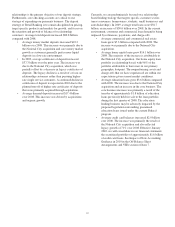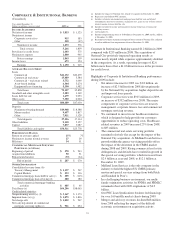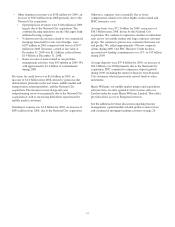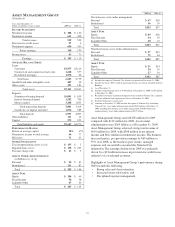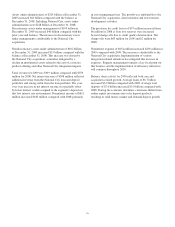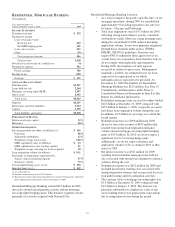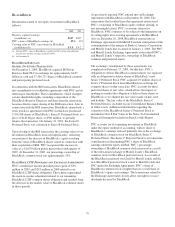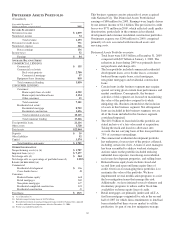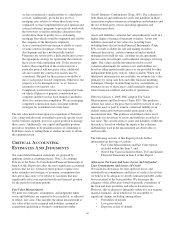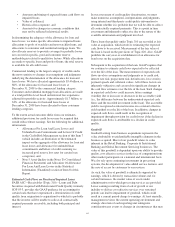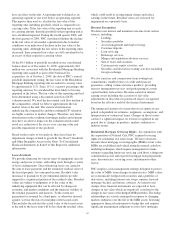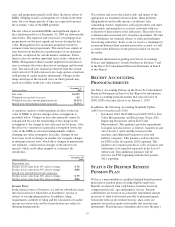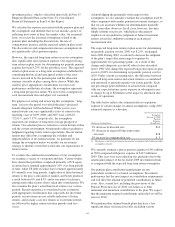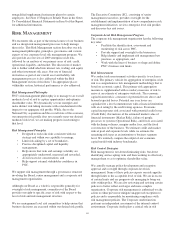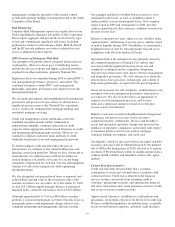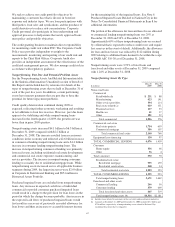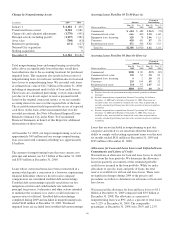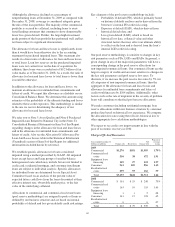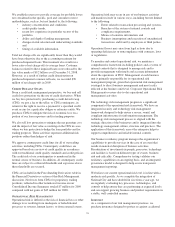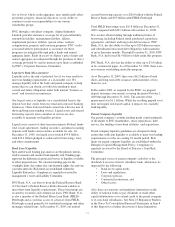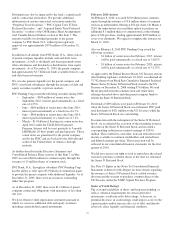PNC Bank 2009 Annual Report Download - page 66
Download and view the complete annual report
Please find page 66 of the 2009 PNC Bank annual report below. You can navigate through the pages in the report by either clicking on the pages listed below, or by using the keyword search tool below to find specific information within the annual report.have an effect on the unit. A reporting unit is defined as an
operating segment or one level below an operating segment.
This input is then used to calculate the fair value of the
reporting unit, including goodwill, which is compared to its
carrying value. If the fair value of the reporting unit exceeds
its carrying amount, then the goodwill of that reporting unit is
not considered impaired. During the fourth quarter 2008, and
the first quarter of 2009, PNC considered whether the decline
in the fair value of our market capitalization due to market
conditions is an indicator of declines in the fair value of the
reporting units. Although the fair values of the reporting units
decreased, their estimated fair values are still considered to be
in excess of their respective carrying values.
Of the $9.5 billion of goodwill recorded on our consolidated
balance sheet as of December 31, 2009, approximately $43
million was associated with the Residential Mortgage Banking
reporting unit acquired as part of the National City
acquisition. As of October 1, 2009, the date of PNC’s annual
goodwill impairment testing, the fair value of the Residential
Mortgage Banking reporting unit exceeded its carrying value
by approximately 11%. Since 11% is a narrow percentage, this
reporting unit may be considered the most likely to become
impaired in the future. The fair value of this reporting unit had
been determined using a discounted cash flow (DCF)
valuation model. We used the discounted cash flow median of
the comparables, which we believe approximates the fair
market value of the unit. The statistical information
underlying the comparables and the resulting DCF valuation
are highly sensitive to market changes. Therefore, any future
deterioration in the residential mortgage market environment
may have an adverse impact on the valuation which could
result in a reduction of the excess over carrying value and
possible impairment of the goodwill.
Based on the results of our analysis, there have been no
impairment charges related to goodwill. See Note 9 Goodwill
and Other Intangible Assets in the Notes To Consolidated
Financial Statements in Item 8 of this Report for additional
information.
Lease Residuals
We provide financing for various types of equipment, aircraft,
energy and power systems, and rolling stock through a variety
of lease arrangements. Direct financing leases are carried at
the sum of lease payments and the estimated residual value of
the leased property, less unearned income. Residual value
insurance or guarantees by governmental entities provide
support for a significant portion of the residual value. Residual
values are subject to judgments as to the value of the
underlying equipment that can be affected by changes in
economic and market conditions and the financial viability of
the residual guarantors and insurers. To the extent not
guaranteed or assumed by a third party, or otherwise insured
against, we bear the risk of ownership of the leased assets.
This includes the risk that the actual value of the leased assets
at the end of the lease term will be less than the residual value,
which could result in an impairment charge and reduce
earnings in the future. Residual values are reviewed for
impairment on a quarterly basis.
Revenue Recognition
We derive net interest and noninterest income from various
sources, including:
• Lending,
• Securities portfolio,
• Asset management and fund servicing,
• Customer deposits,
• Loan servicing,
• Brokerage services,
• Merger and acquisition advisory services,
• Sale of loans and securities,
• Certain private equity activities, and
• Securities and derivatives trading activities including
foreign exchange.
We also earn fees and commissions from issuing loan
commitments, standby letters of credit and financial
guarantees, selling various insurance products, providing
treasury management services and participating in certain
capital markets transactions. Revenue earned on interest-
earning assets including the accretion of fair value
adjustments on discounts for purchased loans is recognized
based on the effective yield of the financial instrument.
The timing and amount of revenue that we recognize in any
period is dependent on estimates, judgments, assumptions, and
interpretation of contractual terms. Changes in these factors
can have a significant impact on revenue recognized in any
period due to changes in products, market conditions or
industry norms.
Residential Mortgage Servicing Rights – In conjunction with
the acquisition of National City, PNC acquired servicing
rights for residential real estate loans. We have elected to
measure these mortgage servicing rights (MSRs) at fair value.
MSRs are established and valued using discounted cash flow
modeling techniques which require management to make
estimates regarding future net servicing cash flows, taking into
consideration actual and expected mortgage loan prepayment
rates, discount rates, servicing costs, and numerous other
factors.
PNC employs a risk management strategy designed to protect
the value of MSRs from changes in interest rates. MSR values
are economically hedged with securities and a portfolio of
derivatives, including interest-rate swaps, options, forward
mortgage-backed, and futures contracts. As interest rates
change, these financial instruments are expected to have
changes in fair value which are negatively correlated to the
change in fair value of the hedged MSR portfolio. The hedge
relationships are actively managed in response to changing
market conditions over the life of the MSR assets. Selecting
appropriate financial instruments to hedge this risk requires
significant management judgment to assess how mortgage
62


